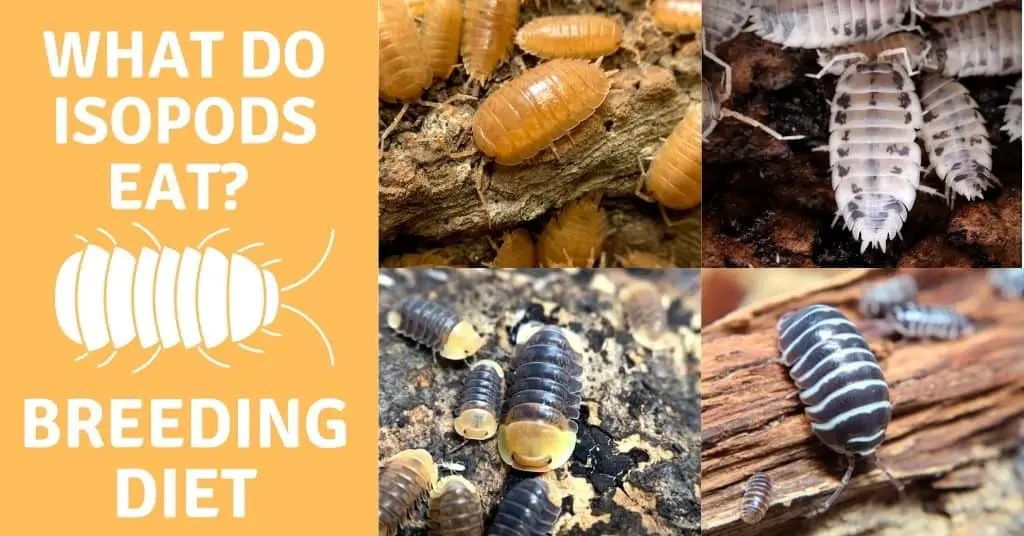
Jeffery Jago is a expert in horticulture and worm breeding. With a background in plant cultivation
Last Updated on May 17, 2021 by Jeffery Jago
An isopod sometimes called a pill bug or roly-poly is an arthropod that lives on land. They are often found in moist areas and can be found outdoors under rocks and logs. There are about 1,500 different species of these little creatures ranging from the plain ordinary grey all the way to the dairy cow isopod and the rubber duck isopods. New species are constantly being discovered in the most unlikely of places.
What do isopods eat?
The main diet
While there are so many amazing species of terrestrial isopods, most of them tend to feed primarily on the same things, decomposing plant material, and fungi.
They also have a high need for calcium to help them grow their exoskeleton, so they often feed on invertebrates that are in the soil like earthworms and snails, mites, and other little creepy crawlies that come their way.
This is necessary for them to do because if they don’t have enough calcium it will affect growth as well as reproduction rates. This can cause a population decline which if you are breeding for a reason, could pose an issue.
Interestingly enough, they cohabitate with springtails without much issue, They may eat them occasionally but for the most part, the 2 species live side by side helping each other out.
Overall, Isopods will simply eat whatever plant materials you give them. Generally, much like mealworms, their substrate is their food and will often be made of a mix of coconut fiber, Moss for water retention, and tons of decaying leaf matter mixed in.
Supplemental Feeding
In the wild, their diet is pretty broad, but in captivity, we can give them things that are more suited to their needs. This is especially important if you want to breed many of them successfully.
You can add extra protein sources in the form of fish food flakes on occasion as a bit of a treat. The extra protein will spur more breeding behaviors and speed up the process of getting some young isopods.
Once and a while you can also add things like fruits, sweet potatoes, etc. Just be sure they are washed very well as pesticides can really hurt your isopods. The same with the skins, they should be completely removed.
You must remove the food from their enclosure after 24 hours or else it will start to rot and start to get moldy.
It is also important to have a moist environment for your isopods as they are terrestrial, so keep the substrate constantly damp but not wet. You can do this by using mosses in their enclosure like sphagnum moss which would help maintain humidity levels naturally. Just get it damp and mix it into their leaf litter substrate.
You want to go for a gradient, where one side of the container is moist and the other is dryer (but not dry). It’s important to remember isopods don’t drink water out of a container, they get it from their environment and from damp soil.
So by creating a gradient, you’re making sure they have enough moisture to stay hydrated but enough variety where they can choose where they want to chill. On the dryer side or the wetter side. It’s going to mainly depend on the species of isopods your keeping.
Why would someone want to breed isopods?
There are many reasons people want to breed isopods. One of the most common reasons people want to breed them is for feeder animals. They are a good food source because they don’t need much care and you can get large numbers from one breeding cycle.
Another reason to breed isopods is as a cleanup crew for their terrariums, vivariums, palidariums, and spider, amphibian, or reptile enclosures. Isopods especially teamed up with springtails, are the best clean-up crew on the planet for terrestrial enclosures.
They can also be quite valuable. Take the rubber ducky isopod, for example, it was only discovered in 2017 Thailand. When it was first found, people wanted to sell them for $250 a piece!
The price has now dropped down to around 30$ per isopod. That’s still incredibly expensive and makes it 100% worth breeding for the resale value alone.
And of course, there are probably other reasons I have simply forgotten to mention.
To recap on what do isopods eat:
- Leaf litter
- Decaying bark
- Decaying plant matter
- Decaying wood
- protein (other insects)
- none decaying plant matter when desperate (rare if their being fed)
- Various fruits and vegetables such as sweet potatoes, carrots, etc.


